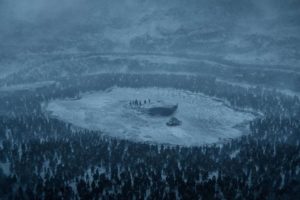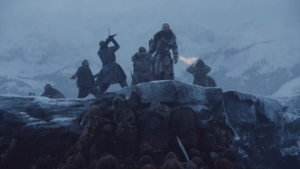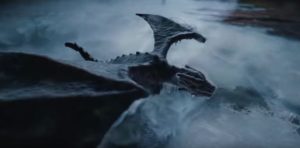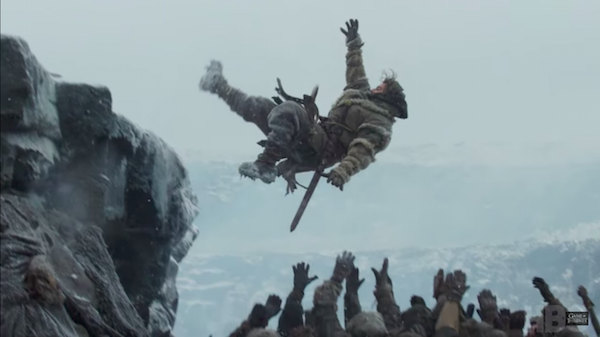The Game of Thrones Frozen Lake Battle: A Roleplaying Perspective
The Frozen Lake Battle in the second to last episode of Game of Thrones season seven was intense. While, yes, the timeline is a bit wonky, let’s overlook that and focus on what we can learn to make our RPG sessions better.
We’re going to assume you have seen the episode, but in case you didn’t, quick recap:
The heroes find themselves stuck on a tiny island on an ice lake, surrounded by skeleton/zombie creatures. The skeletons wait for the ice to get thicker, then move in to attack. The heroes are surrounded on all sides before dragons arrives to save them, one dragon dies and falls into the lake. Very rudimentary, but that’s the gist of it.
 Outnumbered but not unbalanced. The total CR of all of those skeletons was insane. Far, far higher than the party of adventurers. However, as you saw, the forces came in waves. Each as their own encounter. If you wanted to allow the players a chance to get a big fight in there, you could present them with a series of encounters one after the other, allowing the players a moment to breathe, and tweak the rules so that they can spend hit dice to refresh HP between each encounter, like a 30-second-long short rest. Alternatively, taking a vein from 4e, make all the enemies “minions”, with a single HP apiece, guaranteeing they die on the first hit, so that heroes can mow through them faster and make it seem more epic.
Outnumbered but not unbalanced. The total CR of all of those skeletons was insane. Far, far higher than the party of adventurers. However, as you saw, the forces came in waves. Each as their own encounter. If you wanted to allow the players a chance to get a big fight in there, you could present them with a series of encounters one after the other, allowing the players a moment to breathe, and tweak the rules so that they can spend hit dice to refresh HP between each encounter, like a 30-second-long short rest. Alternatively, taking a vein from 4e, make all the enemies “minions”, with a single HP apiece, guaranteeing they die on the first hit, so that heroes can mow through them faster and make it seem more epic. Using terrain. The ice plays a significant role. Once the ice is thick enough, it simply counts as difficult terrain to move across. Before that, however, you could have the ice begin cracking a little. Make a dexterity saving throw to keep from falling into the water. Or you could determine that after a certain number of characters are on the ice it begins to weaken. Last winter, while out delivering mail, I was shuffling across some ice I assumed was thick enough. I heard a crack. After a series of my own DEX checks, I made it off the small pond before it collapsed. It can be pretty hazardous. Back on the topic of terrain, the heroes in the battle are up on the high ground, giving them advantage on their attacks, which can help mitigate the sheer number of skeletons attacking, guaranteeing success on the heroes attacks.
Using terrain. The ice plays a significant role. Once the ice is thick enough, it simply counts as difficult terrain to move across. Before that, however, you could have the ice begin cracking a little. Make a dexterity saving throw to keep from falling into the water. Or you could determine that after a certain number of characters are on the ice it begins to weaken. Last winter, while out delivering mail, I was shuffling across some ice I assumed was thick enough. I heard a crack. After a series of my own DEX checks, I made it off the small pond before it collapsed. It can be pretty hazardous. Back on the topic of terrain, the heroes in the battle are up on the high ground, giving them advantage on their attacks, which can help mitigate the sheer number of skeletons attacking, guaranteeing success on the heroes attacks. Turning the tide. The heroes are soon overwhelmed. Remember, anyone can choose to use non-lethal damage, so even if a hero gets taken down, they don’t have to die. They can simply be knocked out of combat. Even then, they don’t have to be unconscious. Have them so badly wounded they’re incapacitated, but still see the chaos going on around them. Once they were completely overcome on the island, that’s when Dany and the dragons arrived to save the day. This would be a bad idea in your own game, having the heroes just get completely deus ex’ed by an NPC character, but there’s precedent in fantasy: The great eagles in Hobbit and LotR. One way you can handle this is to, if you know you want a scene like this ice battle to happen in the future, establish a friendship with some group who COULD rescue them. Imagine: The session before, the players meet up with a group of rangers or griffons, making a great alliance. Then, you have a session happen where they get completely overwhelmed by zombies or whatever minions you want. When this new group shows up, the players still feel like they’ve done something, despite the deus ex, because THEY were the ones who rallied these new troops to their side. It was THEIR OWN actions that caused themselves to be rescued.
Turning the tide. The heroes are soon overwhelmed. Remember, anyone can choose to use non-lethal damage, so even if a hero gets taken down, they don’t have to die. They can simply be knocked out of combat. Even then, they don’t have to be unconscious. Have them so badly wounded they’re incapacitated, but still see the chaos going on around them. Once they were completely overcome on the island, that’s when Dany and the dragons arrived to save the day. This would be a bad idea in your own game, having the heroes just get completely deus ex’ed by an NPC character, but there’s precedent in fantasy: The great eagles in Hobbit and LotR. One way you can handle this is to, if you know you want a scene like this ice battle to happen in the future, establish a friendship with some group who COULD rescue them. Imagine: The session before, the players meet up with a group of rangers or griffons, making a great alliance. Then, you have a session happen where they get completely overwhelmed by zombies or whatever minions you want. When this new group shows up, the players still feel like they’ve done something, despite the deus ex, because THEY were the ones who rallied these new troops to their side. It was THEIR OWN actions that caused themselves to be rescued. Ominous Tidings. After this point, the heroes see one of the dragons die. They think it’s dead, and flee. Setting up massive events that the players bear witness to can dramatically set up future plots. Later, the dragon is resurrected and turned evil, but the heroes don’t know that. All they know is that their ally has died. This has all kinds of cool implications. As an example, Descent into Avernus doesn’t show you the fall of Elturel, but if you play the Fall of Elturel prior to Descent into Avernus, the plot is much more important to you. When you are sent to Avernus to save the day, you’re already invested in Elturel, because its fall played into your own story earlier. In my own home campaign a year ago, the players fled Sigil as it was getting torn apart by magic, setting up a plot in the future (that we sadly never got to).
Ominous Tidings. After this point, the heroes see one of the dragons die. They think it’s dead, and flee. Setting up massive events that the players bear witness to can dramatically set up future plots. Later, the dragon is resurrected and turned evil, but the heroes don’t know that. All they know is that their ally has died. This has all kinds of cool implications. As an example, Descent into Avernus doesn’t show you the fall of Elturel, but if you play the Fall of Elturel prior to Descent into Avernus, the plot is much more important to you. When you are sent to Avernus to save the day, you’re already invested in Elturel, because its fall played into your own story earlier. In my own home campaign a year ago, the players fled Sigil as it was getting torn apart by magic, setting up a plot in the future (that we sadly never got to).
Hopefully this gives you some advice for how you can find inspiration from anywhere, particularly the movies and TV shows we see every day.
Have fun!
Support Dice Monkey with a single payment on Ko-Fi, or become a Dice Monkey Patron. Thank you for your support!


